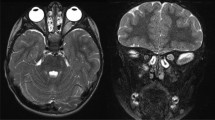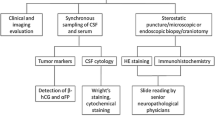Abstract
Patients with marker-positive central nervous system (CNS) germ cell tumors are typically monitored for tumor recurrence with both tumor markers (AFP and b-hCG) and MRI. We hypothesize that the recurrence of these tumors will always be accompanied by an elevation in tumor markers, and that surveillance MRI may not be necessary. We retrospectively identified 28 patients with CNS germ cell tumors treated at our institution that presented with an elevated serum or cerebrospinal fluid (CSF) tumor marker at the time of diagnosis. We then identified those who had a tumor recurrence after having been in remission and whether each recurrence was detected via MRI changes, elevated tumor markers, or both. Four patients suffered a tumor recurrence. Only one patient had simultaneously elevated tumor markers and MRI evidence of recurrence. Two patients had evidence of recurrence on MRI without corresponding elevations in serum or CSF tumor markers. One patient had abnormal tumor markers with no evidence of recurrence on MRI until 6 months later. We conclude that in patients with marker-positive CNS germ cell tumors who achieve complete remission, continued surveillance imaging in addition to measurement of tumor markers is indicated to detect recurrences.
Similar content being viewed by others
References
Keene D, Johnston D, Strother D et al (2007) Epidemiological survey of central nervous system germ cell tumors in Canadian children. J Neurooncol 82(3):289–295
Robertson PL, Jakacki R, Hukin J, Siffert J, Allen JC (2014) Multimodality therapy for CNS mixed malignant germ cell tumors (MMGCT): results of a phase II multi-institutional study. J Neurooncol 118(1):93–100. doi:10.1007/s11060-013-1306-0
Martinez S, Khakoo Y, Gilheeney S et al (2014) Marker (+) CNS germ cell tumors in remission: are surveillance MRI scans necessary? Pediatr Blood Cancer 61(5):853–854. doi:10.1002/pbc.24888
Robison NJ, Campigotto F, Chi SN et al (2014) A phase II trial of a multi-agent oral antiangiogenic (metronomic) regimen in children with recurrent or progressive cancer. Pediatr Blood Cancer 61(4):636–642. doi:10.1002/pbc.24794
Fléchon A, Culine S, Théodore C, Droz JP (2005) Pattern of relapse after first line treatment of advanced stage germ-cell tumors. Eur Urol 48(6):957–963
Oechsle K, Lorch A, Honecker F et al (2010) Patterns of relapse after chemotherapy in patients with high-risk non-seminomatous germ cell tumor. Int Soc Cell 78(1):47–53. doi:10.1159/000292358
Author information
Authors and Affiliations
Corresponding author
Ethics declarations
The study protocol was approved by the Institutional Review Board of NYU Langone Medical Center and was performed in accordance with institutional policies.
Conflict of interest
The authors declare that they have no conflict of interest.
Rights and permissions
About this article
Cite this article
Cheung, V., Segal, D., Gardner, S.L. et al. Utility of MRI versus tumor markers for post-treatment surveillance of marker-positive CNS germ cell tumors. J Neurooncol 129, 541–544 (2016). https://doi.org/10.1007/s11060-016-2207-9
Received:
Accepted:
Published:
Issue Date:
DOI: https://doi.org/10.1007/s11060-016-2207-9




